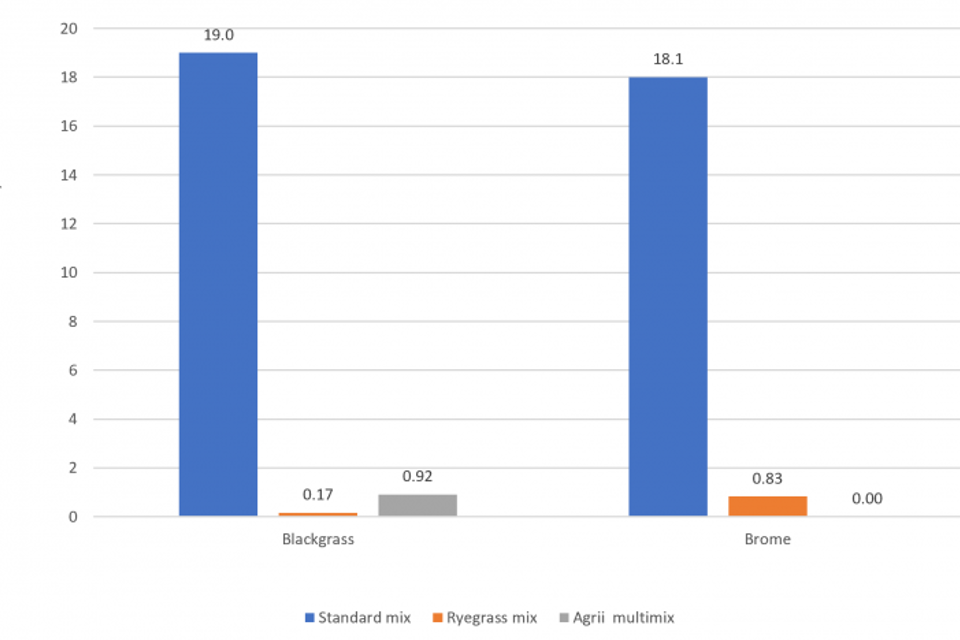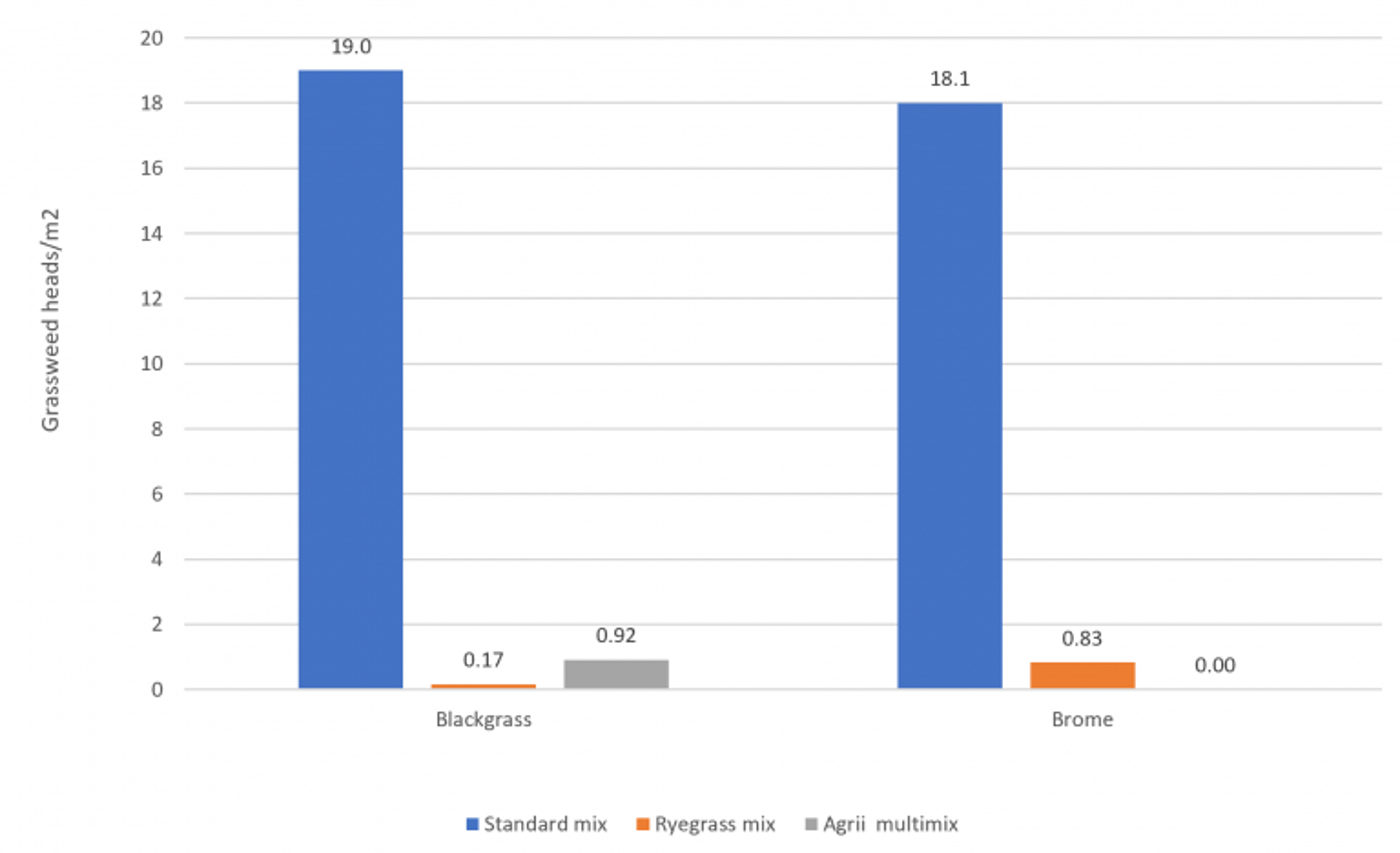
Latest Trials Underline Perennial Grass Importance in AB15 Mixes
News - 15.07.22
Failure to balance AB15 Stewardship mixes sufficiently with perennial grasses may seriously compromise their effectiveness in managing problem grassweeds, confirm the latest replicated farm trials.
The field-scale trials on ground with historic grassweed problems run by farmed environment specialist, Marek Nowakowski at Agrii’s Newton Purcell iFarm involved three legume fallow mixes established in the autumn of 2020 and retained for two years.
Replicated four times in 12mx 200m plots across the field were a legume-only mix, a combination of legumes with perennial ryegrass and a special Agrii multi-mix containing several alternative grasses with 15 legumes and other herbs.
Managed to Stewardship guidelines with three cuts in the first year to deal with emerging grassweeds, all plots developed well and had good levels of ground cover and flowers in their second season; and this despite being sown in strips with a cross-slot drill and rather later than ideal.
Six random 3m2 quadrat counts per plot this June showed substantial differences in both blackgrass and brome populations between the treatments. An average of 19 heads/m2 and 18 heads/m2 respectively were recorded in the no-grass legume mix. In contrast, less than one head/m2 and no brome whatsoever were found in the multi-mix; and the legume and ryegrass mix had less than one head/m2 of both blackgrass and brome (Figure).
“As expected, complete control of annual grassweeds in the first year and a good competitive perennial groundcover going into the second season meant both our grass-containing mixes did a very effective job at preventing more blackgrass and brome emergence from the seedbank,” comments Mr Nowakowski.
“Almost 20 times the grassweed population in the no-grass legume mix underlines what I’ve seen consistently in trials dating back to the 2013 ones with which I was involved in developing AB15 in the first place; namely that blackgrass control, in particular, is much more effective if you include perennial grasses.”
This doesn’t mean you always need grasses in an AB15 mix, Marek Nowakowski hastens to add. Simply, that science shows that including them invariably gives you more chance of keeping on top of annual grassweed problems.
“Herbs on their own tend to grow too slowly to develop competitive canopies going into the winter,” he explains. “This gives far too much space for annual weeds to come through; especially on ground carrying significant weed seed burdens.
“The name of the game with annual grassweeds has to be to prevent them setting seed by repeated mowing in the first year while building-up a competitive sward that shuts out further emergence and establishment from then on.
“Our latest trials confirm how effective perennial ryegrasses can be at doing this. But for those nervous about growing ryegrass there are plenty of other grass species we know will do a great job. These include the crested dog’s tail, slender creeping fescue, Chewings fescue and smooth meadow grass we included in our even more effective trial multi-mix.
“It’s important to appreciate that grasses like these are at least as valuable as many flowers as food sources for a wide range of insects and birds. So, having them in the mix is also an environmental positive.”
From the wildlife point of view as well as in grassweed control and any soil structuring value, Mr Nowakowski sees the official 50% common vetch inclusion guideline as unfortunate, pointing out that birdsfoot trefoil is a better alternative; not least for its much more valuable and competitive canopy and its deep rooting.
“Of course, you don’t have to stick to the guidelines these days,” he points out. “The danger, however is if something goes wrong. You’re likely to be in the clear here if you’ve followed the guidelines. If you haven’t, though, you risk losing your AB15 payment.”
Mr Nowakowski has always recommended sowing in first half of August for the best establishment, and broadcasting rather than drilling to give the most even groundcover. Alongside these he has several other long-standing science and experience-based tips for AB15 success.
First and foremost, he suggests those that need to put the maximum pressure on problem grassweeds think seriously about good inclusions of perennial grasses in their mixes.
“Even with the relatively open structure cross-slot drilling gave at Newton Purcell, we achieved much better blackgrass and brome control with mixes containing grasses,” he stresses. “With the new rules specifying a maximum of three years in the same place against the minimum of three years we originally designed AB15 for, ensuring the most competitive cover from the word go is especially important.
“When and how often you cut in the first year is also key. As blackgrass re-heads more rapidly after each cut and seeds take a relatively long time to mature and become viable after heading, I never advise mowing before the end of flowering – generally in late May/early June.
“Holding your nerve like this means two or three mowings should be quite sufficient. Starting too early – unless you need to help the mix establish in the face of a very dense initial weed burden – could mean you have to cut more than three times to prevent any weed seed return.”
The final, crucial part of the equation in Mr. Nowakowski’s experience is getting the following wheat crop into the ground without waking-up any remaining grassweed seed.
This may not have been so critical with the five-year duration AB15 was originally designed for, given the extent of the loss of viability of the weed seed reservoir in the ground over this time. After just two or three years, however, there is likely to be more than enough viable seed remaining. So, the emphasis has to be on spraying-off the mix effectively with glyphosate and direct drilling the wheat with the least possible spoil movement.
WATCH: Marek gives a video update after the trials day.
“AB15 has proved very popular with growers for its combination of agronomic and environmental benefits,” concludes Marek Nowakowski. “But getting it right is far from as simple as sowing a guideline mix and mowing it repeatedly in year one.
“It hasn’t been made any easier by the way the goalposts have been shifted either. All the trial work I’ve been involved in over many years shows that having a legume-based fallow down for two years is better than one, three years is better than two, and four years is better than three.
“A maximum of three years makes choosing the right mix and managing it correctly through to the establishment of the following wheat crop more essential than ever.”

Figure: Newton Purcell AB15 trial
Standard mix: Common vetch; red clover; lucerne; alsike clover; birdsfoot trefoil (17kg/ha)
Ryegrass mix: Perennial ryegrasses; red clover; common vetch; birdsfoot trefoil;
common knapweed (30kg/ha)
Agrii multimix: Four non-ryegrass grasses; 15 legume and other herb species (20kg/ha)
Join Our Community

Agrii X
We love engaging with clients and partners. Give us a follow and let's share stories for the community.

Agrii Instagram
A picture paints a thousand words. Follow us on Instagram to see what we are up to.

Agrii Facebook
Follow us on the worlds biggest social media site for the latest news and events straight to your feed.

Agrii LinkedIn
If you are all about the business, connect with us on LinkedIn to build your network
Stay In Touch

Journal Sign-Up
Receive email updates on topical news and information from around Agrii and UK Farming.

Listen To Our Podcasts
Listen to the Tramlines Podcast. Fortnightly chat about agriculture and trials with your host Tony Smith.

Agrii Insights
Read essential agri intelligence for profitable farming.

Find an Event
Join us for our upcoming events and tours.



